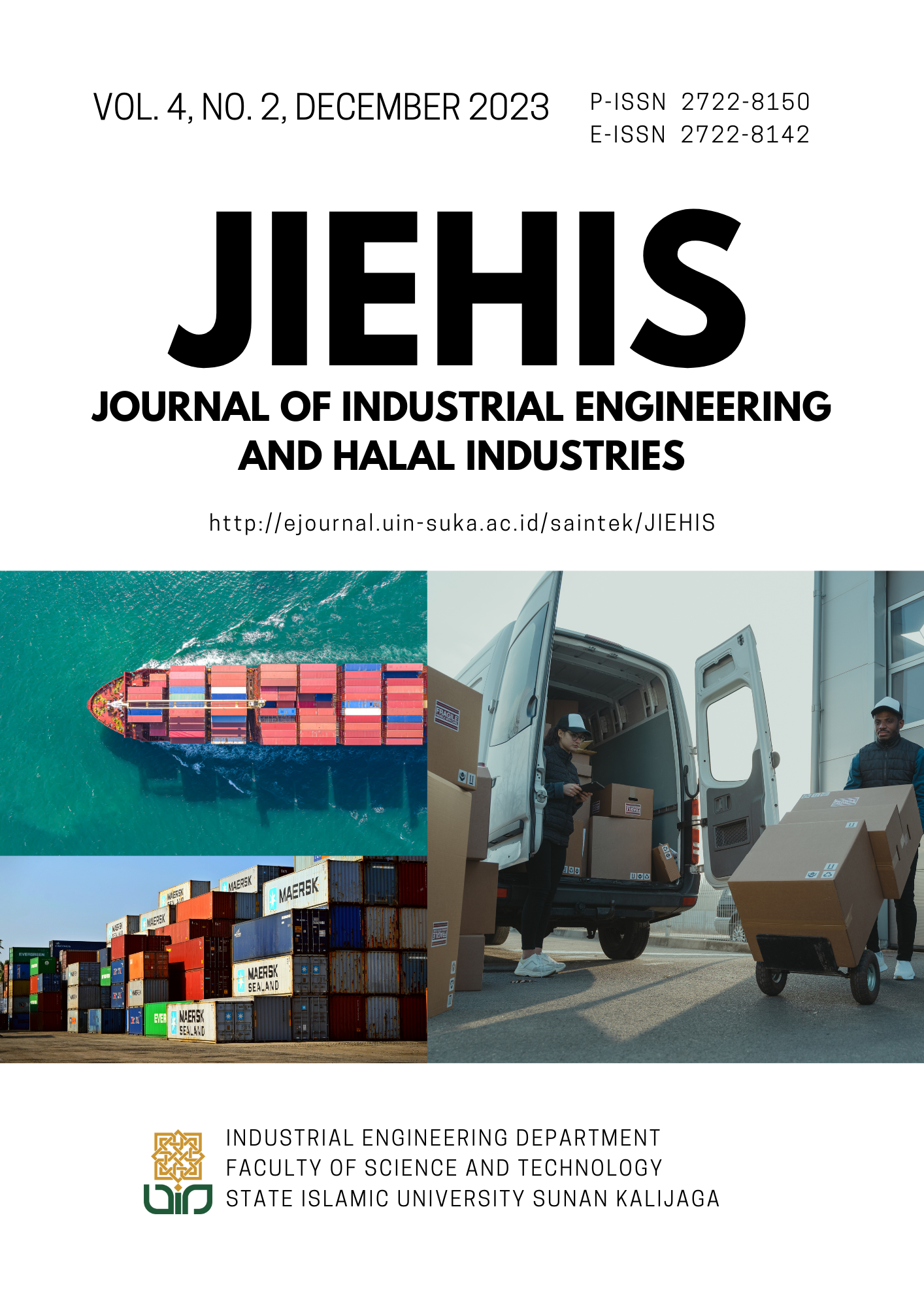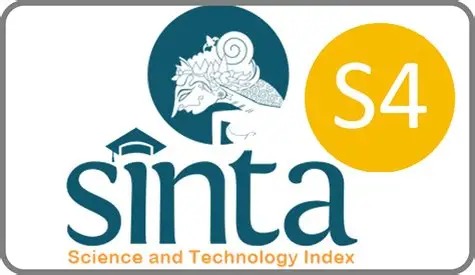Waste Reduction Analysis with Lean Manufacturing Approach
DOI:
https://doi.org/10.14421/jiehis.4218Keywords:
Normal Time, Standard Time, Cycle Time, Takt Time, Fishbone Diagram, Value Stream Mapping, Valsat, Line Balancing, Activity Relationships Chart, Diagram CorlapAbstract
UPT Logam Yogyakarta is one of the manufacturing industries engaged in metal casting services. UPT Logam Yogyakarta has the status of a Regional Business Service Agency so that this company has the capacity to receive requests from local and foreign consumers. One of the requests produced is the product Panasonic Downlight NN511. The problem that occurs in this company is the waste that occurs in the production process which results in losses to the company because the production output is not optimal. This can be indicated from the capacity of the production machine in the form of a sophisticated automated die casting machine with the ability to produce a Panasonic Downlight NN511 product per 45 seconds that cannot be utilized optimally, due to an unbalanced production path caused by waste and non-value added time. As a result, the production capacity of 1040 pcs per day cannot be achieved, and is only able to produce at the rate of 200-300 pcs. As a calculation reference to determine the degree of accuracy, a adequacy and uniformity test of the data will be carried out, then calculate the rating factor and determine the allowance for the calculation of normal time and standard time. After testing and adjusting the data with the factor rating and allowance, it was found that there was a cycle time that was greater than the taktime, it explained that the metal UPT had to reduce the cycle time at the finishing and packaging stations to be able to meet customer demands. One of the large proportions of waste is the waiting time in the production process. The analysis to determine the root cause of the problem is carried out using a fishbone diagram. To optimize available resources and increase production efficiency, several continuous improvements are needed in the flow pattern of the Panasonic Downlight NN511 production process. balancing, compiling the layout using Activity Relationships Chart, and collapsing diagrams. From these improvements, it is hoped that Yogyakarta Metals UPT in producing the Panasonic Downlight NN511 can achieve a higher level of productivity.
References
Fernando, Y. C., Noya, S. 2014. Optimasi Lini Produksi Dengan Value Stream Mapping Dan Value Stream Analysis Tools. Jurnal Ilmiah Teknik Industri Vol. 13, No. 2.
Heri Murnawan, Mustofa. 2014. Perencanaan Produktivitas Kerja dari Hasil Evaluasi Produktivitas dengan Metode Fishbone di Perusahaan Percetakan Kemasan PT.X. Jurnal Teknik Industri HEURISTIC. Vol. 11. No. 1.
Jakfar, Ahmad et al. 2014. Pengurangan Waste menggunakan Pendekatan Lean Manufacturing. Jurnal Ilmiah Teknik Industri. Vol.13. No.1.
Lestari, Kartika dan Susandi, D. 2019. Penerapan Lean Manufacturing untuk mengidentifikasi waste pada proses produksi kain knitting di lantai produksi PT. XYZ. Industrial Research Workshop and National Seminar.
Muhammad, C.R., dan Prasetyaningsih, E., 2014. Peningkatan Kinerja Operasional Industri Kerajinan Kulit Dengan Pendekatan Lean Manufacturing (Studi Kasus di Cibaduyut- Bandung). Prosiding Seminar Nasional Penelitian dan PKM: Sains, Teknologi, dan Ilmu Kesehatan. Bandung: Universitas Islam Bandung
Panudju,Tri A. et al. 2018. Analisis Penerapan Konsep Penyeimbangan Lini (Line Balancing) dengan Metode Ranked Position Weight (RPW) pada Sistem Produksi Penyamakan Kulit di PT. Tong Hong Tannery Indonesia Serang Banten. JISI : Jurnal Integrasi Sistem Industri. Vol. 5. No. 2.
Ramadhan, M. I. et al. 2018. Analisis Kelayakan Aspek Teknis Industri Pengolahan Biofarmaka Berbahan Baku Bawang Tiwai. Jurnal Rekayasa Sistem Industri. Vol.7, No.2.
Ravizar, Agung dan Rosihin, Rosihin. 2018. Penerapan Lean Manufacturing untuk Mengurangi Waste pada Produksi Absorbent. Jurnal INTECH Teknik Industri
Rother, M., dan Shock, J., 1999. Learning To See: Value Stream Mapping To Create Value and Eliminate Muda. Brookline, MA : The Lean Enterprise Institute.
Safitri, N. D. dkk. 2017. Analisis perancangan tataletak fasilitas produksi menggunakan metode activity relationship chart (ARC). Jurnal Managemen , 38 – 47. Vol. 9 (1)
Setiyawan, Danang T. et al. 2017. Usulan Perbaikan Tata Letak Fasilitas Produksi Kedelai Goreng dengan Metode BLOCPLAN dan CORELAP (Studi Kasus pada UKM MMM di Gading Kulon, Malang). Jurnal Teknologi dan Manajemen Agroindustri. Vol.6 No. 1:51-60.
Trenggonowati, D Lintang. dan Nuzilia Febriana. 2019. Mengukur Efisiensi Lintasan dan Stasiun Kerja menggunakan Metode Line Balancing Studi Kasus PT. XYZ. Journal Industrial Servicess Vol.4 No.2.
Widyahening, C. E. T. 2018. Penggunaan Teknik Pembelajaran Fishbone Diagram Dalam Meningkatkan Keterampilan Membaca Siswa. Fakultas Keguruan dan Ilmu Pendidikan Universitas Slamet Riyadi. Jurnal Komunikasi Pendidikan Vol. 2, No. 1.
Womack, James P. and Daniel T. Jones. 2003. Lean Thinking: Banish Waste and Create Wealth in your corporation. Second Edition. London: Free Press Business.
Yola, Melfa et al. 2017. Value Stream Mapping untuk Mereduksi Waste Dominan dan Meningkatkan Produktivitas Produksi di Industri K. Jurnal Hasil Penelitian dan Karya Ilmiah dalam bidang Teknik Industri. Vol. 3, No.2
Downloads
Published
How to Cite
Issue
Section
License
Copyright (c) 2024 Eulis Yulianti Faridah, Yonathan

This work is licensed under a Creative Commons Attribution-ShareAlike 4.0 International License.
(c) The Author(s). This article is distributed under a Creative Commons Attribution-ShareAlike 4.0 International License.






